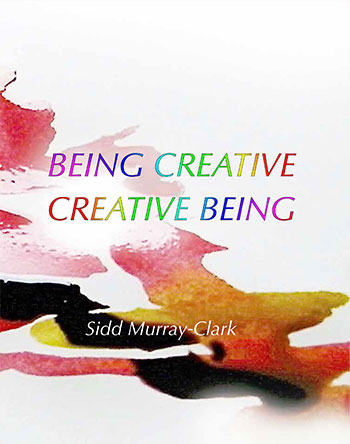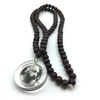Being Creative · Creative Being: Painting the inner journey

Punya reviews Siddhena’s book that is being launched today, 18th January 2020 in Tokyo; “A treasure trove… packed with insights, suggestions and projects.”
Being Creative · Creative Being
Painting the inner journey
by Sidd Murray-Clark (Siddhena)
Paperback, 195 x 247 cm, full-colour print
Includes a boxed set of 44 CreativePlay Cards
More on creativlife.net
Soon available on amazon
To write a review in the given length and still do justice to this treasure trove is difficult. It looks like an art manual, but do not be deceived: it’s packed with goodies, a cornucopia of insights, suggestions, projects, exercises, overflowing on all edges of the paper.
The best way to introduce it may be to quote Siddhena’s own words:
“This book is not a manual to show you how or what to do. It is to inspire a play between your inner world and creative expression to quicken your creative pulse, explore your inner spaces, to tune your sensitivity and expand your sense of wonder. If you come to something it will be by your own discovery rather than from following instructions. You will find yourself in new territory, not because you have a map but because you have the curiosity and sense of adventure.”
Being Creative · Creative Being is beautifully designed. It is a big book (almost letter size), printed on heavy mat coated paper, illustrated with countless colour photographs, paintings and drawings. You would want to leave it open on your side table and leaf through it from time to time. Read a page, let the meaning sink in, as one would while standing before a painting, and come back to it at another time, read another page or do one of the projects.
To list the chapter titles might be not very creative from my part, but they give, at a glance, a good overview of the content:
The Creative Pulse
Putting the Water in the Glass – Creative limits
Your Art, Your Mirror – Inspiration & Expression
Doing the Not Doing – Activity & Stillness
Formless into Form – Nature and Resonance
Play & The Cosmic Dance – Innocence & Connectivity
Method & Practicals
The Projects
Almost all chapters include five or six projects. In total there are 30 exercises that can be done alone, with a (painting) partner or in a larger group. These instructions certainly come from Siddhena’s long-time experience as a meditator, artist and art teacher. “All the projects in this book involve both meditation and drawing in some combination,” he writes. “A combination of the world outside (the painting in front of us, the canvas, the sheet of paper, the paints, the charcoal) and the inner world (What is happening within me? How do I feel? Where is the point of silence?).” Like a Zen master he is not letting you escape right or left and evade the question, like for instance this one:
“Besides these polarities of color and application what other polarities from life could you explore? Maybe suggestive vs. obvious, worldly vs. symbolic, etc.? As you develop this, observe if this process of merging opposites balances or ‘heals’ apparent conflicts inside yourself.”
I do not know if I would be able to do some of the projects on my own, as I tend to easily get lost in what I am doing. But if he were there right next to me like a Zen master it would be easier to be present, stop and ask myself what is happening to me. It might help, though, to have the book open next to me, or make myself a note in big letters of the enquiry I am asked to do, what I have to become aware of, during the process.
I must not have been the only one to think of that because the book comes with a set of 44 CreativePlay cards printed in full-colour. If you are stuck somewhere, if there is a moment of hesitation or a big question mark arises while painting, or just for fun, you can pull a card that can give you a new direction, taking you to a new exploration. Of course the cards can also be pulled before starting; each card’s message will then be the theme of that particular painting. Possibilities: Invisible/Visible, Deliberate Movements, Freedom/Limitation, Point of Focus, etc.
It might now come across as if this book is one of the many how-to art manuals, a booklet you read through, promise yourself to start painting again, and then store in some hidden corner of your bookshelf. But this is not so. I have not yet talked about the main part.
The Main Text – The Maxims
Being Creative · Creative Being feels to me like the crystallization of the wisdom that has arisen from deep within the author, the crystallization of what he has learned, absorbed from the sages, gathered from his experience as an artist, meditator and art teacher.
The writing is compact, one sentence after the other, each reading like a maxim. And one has to savour one word after the other. Savour, slowly. Sometimes the sentences need to be read twice. Sometimes not easy on the tongue, but Siddhena manages the impossible: to describe what is happening to a painter while painting.
There were pieces which I relished reading, for instance where he says that we do not have to follow what he says but to make our own discoveries. We read an interesting short essay about the evolution of art in human history, a discussion about conditioning, growing up and becoming a teenager, playfulness and curiosity, spontaneity, being in the present, our connection to our body, about which a quote here:
“When we paint or when we play we are coming back to ourselves, primarily because we follow our body and its movement. This physical freedom is very honest and direct. To express this way depends solely on our openness to the possibilities. Because our mind nearly always follows what it knows, and to sidestep that limitation on our creativity, freely expressive painting like this short-circuits such patterns and predictable habits. The moment you find yourself trying or becoming cautious, you can pretty much see that your habitual mind is trying to reassert itself.”
I particularly respected that Siddhena uses his very own phraseology, no borrowed terms from our Master; he makes the effort to clothe his thought in his very own words. It just shows that what he writes has been digested, deeply experienced – and not just heard about.
An eye-opener about limitation (we always think limitation is something negative…):
“Conscious limits don’t exclude spontaneity,
they make better use of it.”
I have collected three pages of my favourite quotes, here are another few:
“Doing something well is not about doing something correctly;
it is about doing something with wellness.
Beauty comes through this wellness, not through some idea
of aesthetic perfection.”
“Innocence is openness, the way to see things afresh,
without labels or preconceptions. Innocence means not knowing.”
“With awareness any flow of activity is a meditative action.
So meditation is not necessarily cessation of activity,
it’s that full awareness of life as it happens in the moment.
Meditation, or whatever word you want to call it
is ultimately you being you – but fully you!”
“Enquiry is not about finding answers, but about keeping
an open mind. Originality is to simply be yourself,
and to be yourself is to love yourself.
Uniqueness does not need to be proved.
It needs to be accepted – you are already unique!”
Japan
The illustrations in the book reveal that Siddhena has a deep connection with Japan. He has lived there, working as an artist and teacher for 13 years. He has imbibed the wisdom of Zen in his blood and bones. Or maybe it’s the other way round, he lives there because it is the place he needs to be – or both. For instance, very much inspired by Japan are the Projects 23 and 24, “Drawing on You” and “Full on Empty.”
The combination of his western upbringing and his understanding of Zen makes this book accessible to anyone, new and experienced painters, new and old meditators, from the East or the West.
The Legacy
Many times the thought came to me that this book is actually Siddhena’s legacy: as if these were the words a Zen master would tell his students before he leaves on a journey. It’s written for his friends, his students and his unknown readers about every detail he has understood and wants to share with them.
The whole book has the feel of Go and explore, Don’t just wait there, move on, Don’t remain with the status quo, Life – and creativity – is such an adventure!
It’s a wonderful book to spend time with – you will get inspired time and time again.
Siddhena (Sidd Murray-Clark): “In 1977 I dropped out of a London career in art and design, and into the world of Osho. My creativity took on a whole new life in his communes, whether bricklaying or designing the theatre group sets. Through the years in Rajneeshpuram and again in Poona this took the form of city planning and landscaping. I was always blessed with the opportunity to contribute in many creative ways, designing Osho’s books, laying out Osho Teerth Park and designing interiors for the new buildings. I now create, exhibit and enjoy in Japan.” siddart.com – creativlife.net – facebook.com/ArtistEastWest
Punya is the founder of Osho News, author of many interviews and of her memoir On the Edge.
- Log in to post comments
- 6 views
